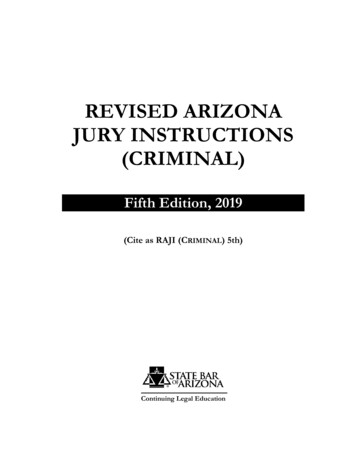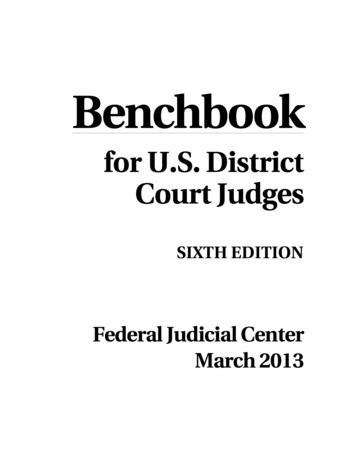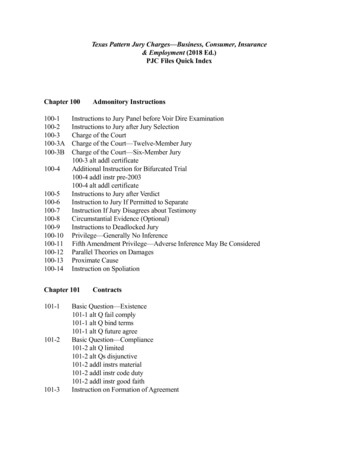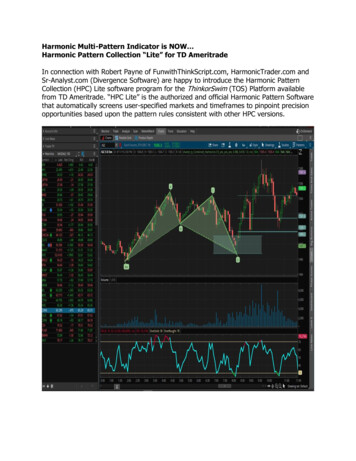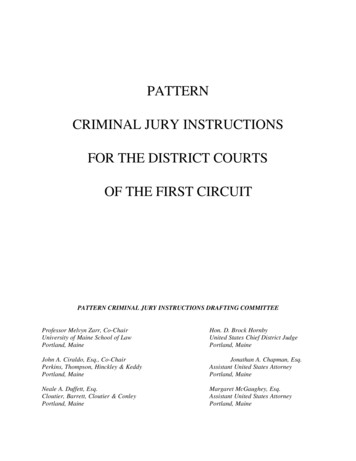
Transcription
PATTERNCRIMINAL JURY INSTRUCTIONSFOR THE DISTRICT COURTSOF THE FIRST CIRCUITPATTERN CRIMINAL JURY INSTRUCTIONS DRAFTING COMMITTEEProfessor Melvyn Zarr, Co-ChairUniversity of Maine School of LawPortland, MaineHon. D. Brock HornbyUnited States Chief District JudgePortland, MaineJohn A. Ciraldo, Esq., Co-ChairPerkins, Thompson, Hinckley & KeddyPortland, MaineJonathan A. Chapman, Esq.Assistant United States AttorneyPortland, MaineNeale A. Duffett, Esq.Cloutier, Barrett, Cloutier & ConleyPortland, MaineMargaret McGaughey, Esq.Assistant United States AttorneyPortland, Maine
PATTERN CRIMINAL JURY INSTRUCTIONSFOR THE FIRST CIRCUITPrefaceCitations to Other Pattern InstructionsHow to Use the Pattern InstructionsPart 1Preliminary rt 2Duties of the JuryNature of Indictment; Presumption of InnocencePrevious TrialPreliminary Statement of Elements of CrimeEvidence; Objections; Rulings; Bench ConferencesCredibility of WitnessesConduct of the JuryNotetakingOutline of the TrialInstructions Concerning Certain Matters of EvidenceIntroductory Comment2.01 Stipulations2.02 Impeachment by Prior Inconsistent Statement2.03 Impeachment of Witness Testimony by Prior Conviction2.04 Impeachment of Defendant’s Testimony by Prior Conviction2.05 Evidence of Defendant’s Prior Similar Acts2.06 Weighing the Testimony of an Expert Witness2.07 Caution as to Cooperating Witness/Accomplice/Paid Informant2.08 Use of Tapes and Transcripts2.09 Flight After Accusation/Consciousness of Guilt2.10 Statements by Defendant2.11 Missing Witness2.12 Witness (Not the Defendant) Who Takes the Fifth Amendment2.13 Definition of “Knowingly”2.14 “Willful Blindness” As a Way of Satisfying “Knowingly”2
Part 3Final Instructions: General Considerations3.013.023.033.043.053.063.073.08Part 4Duty of the Jury to Find Facts and Follow LawPresumption of Innocence; Proof Beyond a Reasonable DoubtDefendant’s Constitutional Right Not to TestifyWhat Is Evidence; InferencesKinds of Evidence: Direct and CircumstantialCredibility of WitnessesCautionary and Limiting Instructions as to Particular Kinds of EvidenceWhat Is Not EvidenceFinal Instructions: Elements of Specific CrimesA.Offenses Under Title 184.014.024.034.044.054.06AttemptAid and Abet, 18 U.S.C. § 2Conspiracy, 18 U.S.C. § 371; 21 U.S.C. § 846Escape from Custody, 18 U.S.C. § 751Assisting Escape, 18 U.S.C. § 752Possession of a Firearm or Ammunition in or Affecting Commerce by aConvicted Felon, 18 U.S.C. § 922(g)Using or Carrying a Firearm During and in Relation to Drug Trafficking orCrime of Violence, 18 U.S.C. § 924(c)Making a False Statement to a Federal Agency,18 U.S.C. § 1001Making a False Statement or Report, 18 U.S.C. § 1014Access Device or Credit Card Fraud,18 U.S.C. § 1029(a)(2)Harboring or Concealing an Escaped Prisoner,18 U.S.C. § 1072Mail Fraud, 18 U.S.C. § 1341Wire Fraud, 18 U.S.C. § 1343Bank Fraud, 18 U.S.C. § 1344(1) & (2)False Statement in Document Required by Immigration Law, 18 U.S.C.§ 1546(a)Interference with Commerce by Robbery or Extortion (Hobbs Act), 18U.S.C. § 1951Money Laundering—Illegal Structuring, 18 U.S.C. § 1956Unarmed Bank Robbery, 18 U.S.C. § 2113(a)Armed or Aggravated Bank Robbery,18 U.S.C. § 2113(a), (d)Interstate Transportation of Stolen Money or Property,18 U.S.C. § 184.194.203
B.Offenses Under Other Titles4.21Immigration Through Fraudulent Marriage,8 U.S.C. § 1325(c)Possession with Intent to Distribute a Controlled Substance,21 U.S.C. § 841(a)(1)Distribution of a Controlled Substance, 21 U.S.C. § 841(a)(1)Manufacture of a Controlled Substance,21 U.S.C. §§ 841(a)(1), 802(15)Income Tax Evasion, 26 U.S.C. § 7201Failure to File a Tax Return, 26 U.S.C. § 7203False Statements on Income Tax Return, 26 U.S.C. § 7206(1)Money Laundering—Illegal Structuring,31 U.S.C. §§ 5322, 53244.224.234.244.254.264.274.28Part 5Final Instructions: Defenses and Theories of DefenseIntroductory Comment5.01 Alibi5.02 Mental State That Is Inconsistent with the Requisite Culpable State of Mind5.03 Intoxication5.04 Self-Defense5.05 Duress5.06 Entrapment5.07 InsanityPart 6Final Instructions: Deliberations and Verdict6.016.026.036.046.056.06Foreperson’s Role; UnanimityConsideration of EvidenceReaching AgreementReturn of Verdict FormCommunication with the CourtCharge to a Hung JuryAfterword: How to Draft a Charge4
PREFACEAt the First Circuit Judicial Conference on October 1, 1997, the assembled federaljudges voted to approve the publication of these pattern instructions. Although webelieve that the pattern instructions and, in particular, the commentary thataccompanies them will be helpful in crafting a jury charge in a particular case, it bearsemphasis that no district judge is required to use the pattern instructions, and that theCourt of Appeals has not in any way approved the use of a particular instruction.It is our hope to keep these pattern instructions updated as the law develops. As aresult, we welcome any suggested modifications or improvements. In addition, weinvite the submission of pattern charges for any other commonly charged crimes in theFirst Circuit.Particular thanks are due to Professor Melvyn Zarr of the University of Maine Schoolof Law and John Ciraldo of Perkins, Thompson, Hinckley & Keddy who co-chairedthe drafting committee, as well as to each of the members of that committee whoworked diligently to produce these pattern instructions.D. Brock HornbyUnited States Chief District JudgeDistrict of Maine11/975
CITATIONS TO OTHER PATTERN INSTRUCTIONSWe have abbreviated our citations to other pattern instructions as follows:Fifth Circuit Instruction . . . . .Fifth Circuit District Judges AssociationPattern Jury Instructions Committee, PatternJury Instructions, Criminal Cases (1990)Sixth Circuit Instruction . . . . .Sixth Circuit District Judges AssociationPattern Criminal Jury Instructions Committee,Pattern Criminal Jury Instructions (1991)Eighth Circuit Instruction . . . . .Eighth Circuit Committee on Model CriminalJury Instructions, Manual of Model CriminalJury Instructions for the District Courts of theEighth Circuit (1996)Ninth Circuit Instruction . . . . .Ninth Circuit Committee on Model CriminalJury Instructions, Manual of Model CriminalJury Instruction for the District Courts of theNinth Circuit (1995)Eleventh Circuit Instruction . . . . .Eleventh Circuit District Judges AssociationPattern Jury Instructions Committee, PatternJury Instructions, Criminal Cases (1985)Federal Judicial CenterInstruction . . . . .Sand, et al., Instruction . . . . .Federal Judicial Center, Pattern Criminal JuryInstructions (1988)Leonard B. Sand et al., Modern Federal JuryInstructions (Nov. 1996)6
HOW TO USE THE PATTERN INSTRUCTIONSThese instructions will function best if specific references to the case being tried areinserted. For example, every time we have put the word “defendant” in brackets weintend the instructing judge to substitute the defendant’s actual name. The same holdstrue when the word “witness” is bracketed. General studies of juror understandingsuggest that juries understand better when actual names are used rather than terms like“defendant” or “witness.” On the same rationale, we have used the term “I” ratherthan the third person “the court” when referring to the judge. Finally, where we havegiven alternatives, select the alternative(s) that best fit(s) the evidence in your case.7
PART 1PRELIMINARY INSTRUCTIONS1.01Duties of the Jury1.02Nature of Indictment; Presumption of Innocence1.03Previous Trial1.04Preliminary Statement of Elements of Crime1.05Evidence; Objections; Rulings; Bench Conferences1.06Credibility of Witnesses1.07Conduct of the Jury1.08Notetaking1.09Outline of the Trial8
1.01Duties of the JuryLadies and gentlemen: You now are the jury in this case, and I want to take a fewminutes to tell you something about your duties as jurors and to give you someinstructions. At the end of the trial I will give you more detailed instructions. Thoseinstructions will control your deliberations.It will be your duty to decide from the evidence what the facts are. You, and youalone, are the judges of the facts. You will hear the evidence, decide what the factsare, and then apply those facts to the law I give to you. That is how you will reachyour verdict. In doing so you must follow that law whether you agree with it or not.The evidence will consist of the testimony of witnesses, documents and other thingsreceived into evidence as exhibits, and any facts on which the lawyers agree or whichI may instruct you to accept.You should not take anything I may say or do during the trial as indicating what I thinkof the believability or significance of the evidence or what your verdict should be.Comment(1)This instruction is derived from Ninth Circuit Instruction 1.01.(2)“[J]urors may have the power to ignore the law, but their duty is to apply thelaw as interpreted by the court, and they should be so instructed.” United States v.Boardman, 419 F.2d 110, 116 (1st Cir. 1969) (citing Sparf & Hansen v. United States,156 U.S. 51 (1895)), cert. denied, 397 U.S. 991 (1970). Thus, while a jury may acquitan accused for any reason or no reason, see Horning v. District of Columbia, 254 U.S.135, 138 (1920) (“[T]he jury has the power to bring in a verdict in the teeth of bothlaw and facts.”), trial judges may not instruct the jurors about this power ofnullification. See United States v. Manning, 79 F.3d 212, 219 (1st Cir.), cert. denied,U.S. , 117 S. Ct. 147 (1996); United States v. Sepulveda, 15 F.3d 1161, 1190(1st Cir. 1993) (citing United States v. Desmarais, 938 F.2d 347, 350 (1st Cir. 1991)(collecting cases)), cert. denied, 512 U.S. 1223 (1994); see also United States v.Garcia-Rosa, 876 F.2d 209, 226 (1st Cir. 1989) (this position “is consistent with thatof every other federal appellate court that has addressed this issue”), cert. denied, 493U.S. 1030, and cert. granted, vacated on other grounds, 498 U.S. 954 (1990); UnitedStates v. Trujillo, 714 F.2d 102, 105-06 (11th Cir. 1983) (collecting cases).Furthermore, “[t]his proscription is invariant; it makes no difference that the juryinquired, or that an aggressive lawyer managed to pique a particular jury’s curiosity bymentioning the subject in closing argument, or that a napping prosecutor failed to raisea timely objection to that allusion.” Sepulveda, 15 F.3d at 1190.9
During the closing arguments in Sepulveda one of the defendants’ attorneysinvited the jury to “send out a question” concerning jury nullification; the jury did so,requesting the trial judge to “[c]larify the law on jury nullification.” Id. at 1189. Thejudge responded with the following, which was affirmed by the First Circuit:Federal trial judges are forbidden to instruct on jurynullification, because they are required to instruct only on thelaw which applies to a case. As I have indicated to you, theburden in each instance which is here placed upon theGovernment is to prove each element of the offenses . . .beyond a reasonable doubt, and in the event the Governmentfails to sustain its burden of proof beyond a reasonable doubtas to any essential element of any offense charged against eachdefendant, it has then failed in its burden of proof as to suchdefendant and that defendant is to be acquitted. In short, if theGovernment proves its case against any defendant, you shouldconvict that defendant. If it fails to prove its case against anydefendant you must acquit that defendant.Id. at 1189-90 (emphases added). Judge Selya explained that the “contrast indirectives” in the last two sentences, “together with the court’s refusal to instruct inany detail about the doctrine of jury nullification, left pregnant the possibility that thejury could ignore the law if it so chose.” Id. at 1190.10
1.02Nature of Indictment; Presumption of InnocenceThis criminal case has been brought by the United States government. I willsometimes refer to the government as the prosecution. The government is representedat this trial by an assistant United States attorney, [ ]. The defendant,[ ], is represented by his/her lawyer, [ ]. [Alternative: Thedefendant, [ ], has decided to represent him/herself and not use theservices of a lawyer. He/She has a perfect right to do this. His/Her decision has nobearing on whether he/she is guilty or not guilty, and it should have no effect on yourconsideration of the case.]The defendant has been charged by the government with violation of a federal law.He/She is charged with [e.g., having intentionally distributed heroin]. The chargeagainst the defendant is contained in the indictment. The indictment is simply thedescription of the charge against the defendant; it is not evidence of anything. Thedefendant pleaded not guilty to the charge and denies committing the crime. He/She ispresumed innocent and may not be found guilty by you unless all of you unanimouslyfind that the government has proven his/her guilt beyond a reasonable doubt.[Addition for multi-defendant cases: The defendants are being tried together becausethe government has charged that they acted together in committing the crime of[ ]. But you will have to give separate consideration to the case againsteach defendant. Do not think of the defendants as a group.]CommentThis instruction is derived from Federal Judicial Center Instruction 1.11
1.03Previous TrialYou may hear reference to a previous trial of this case. A previous trial did occur. Butthe defendant and the government are entitled to have you decide this case entirely onthe evidence that has come before you in this trial. You should not consider the fact ofa previous trial in any way when you decide whether the government has proven,beyond a reasonable doubt, that the defendant committed the crime.Comment(1)This instruction is derived from Ninth Circuit Instruction 2.09, Federal JudicialCenter Instruction 14, and Sand, et al., Instruction 2-13. The commentary to the NinthCircuit and Federal Judicial Center instructions both recommend that this instructionnot be given unless specifically requested by the defense. See also United States v.Seals, 987 F.2d 1102, 1109-10 (5th Cir.) (finding it was not error to fail to instruct thejury when defense counsel refused trial court’s offer to give instruction followinginadvertent references to the defendant’s previous trial), cert. denied, 510 U.S. 853(1993).(2)The District of Columbia Circuit has suggested that the following cautionaryinstruction be given at the outset of a retrial: “The defendant has been tried before. [Ifthere has been a mistrial, so state.] You have no concern with that. The law chargesyou to render a verdict solely on the evidence in this trial.” Carsey v. United States,392 F.2d 810, 812 (D.C. Cir. 1967) (finding defense counsel’s mention of “mistrials”did not substantially prejudice the prosecution and prevent a fair trial, so that the trialjudge should have handled the matter through a cautionary instruction instead ofdeclaring a mistrial). See also United States v. Hykel, 461 F.2d 721, 726 (3d Cir.1972) (affirming instruction given after mention during jury selection of previousmistrial; instruction cautioning jury that “[T]he fact that this is the second trial of thiscase should mean nothing to you. Do you understand that? No inference of any kindshould be drawn from that.”); cf. United States v. Faulkner, 17 F.3d 745, 763-64 (5thCir.) (affirming court’s statement to jury about true reason for mistrial in context ofnewscasts erroneously reporting that previous trial ended in mistrial due to jurytampering), reh’g denied, 21 F.3d 1110 (5th Cir.), and cert. denied, 513 U.S. 870(1994).12
1.04Preliminary Statement of Elements of CrimeIn order to help you follow the evidence, I will now give you a brief summary of theelements of the crime[s] charged, each of which the government must prove beyond areasonable doubt to make its case:First, [ ];Second, [ ];Third, [ ];etc.[The description of the crime in this preliminary instruction should not simply trackstatutory language but should be stated in plain language as much as possible.]You should understand, however, that what I have just given you is only a preliminaryoutline. At the end of the trial I will give you a final instruction on these matters. Ifthere is any difference between what I just told you, and what I tell you in theinstruction I give you at the end of the trial, the instructions given at the end of the trialgovern.CommentThis instruction is derived from Eighth Circuit Instruction 1.02 and Ninth CircuitInstruction 1.02.13
1.05Evidence; Objections; Rulings; Bench ConferencesI have mentioned the word “evidence.” Evidence includes the testimony of witnesses,documents and other things received as exhibits, and any facts that have beenstipulated—that is, formally agreed to by the parties.There are rules of evidence that control what can be received into evidence. When alawyer asks a question or offers an exhibit into evidence, and a lawyer on the otherside thinks that it is not permitted by the rules of evidence, that lawyer may object.This simply means that the lawyer is requesting that I make a decision on a particularrule of evidence.Then it may be necessary for me to talk with the lawyers out of the hearing of the jury,either by having a bench conference here while the jury is present in the courtroom, orby calling a recess. Please understand that while you are waiting, we are working.The purpose of these conferences is to decide how certain evidence is to be treatedunder the rules of evidence, and to avoid confusion and error. We will, of course, dowhat we can to keep the number and length of these conferences to a minimum.Certain things are not evidence. I will list those things for you now:(1)Statements, arguments, questions and comments by lawyersrepresenting the parties in the case are not evidence.(2)Objections are not evidence. Lawyers have a duty to their client toobject when they believe something is improper under the rules ofevidence. You should not be influenced by the objection. If I sustainan objection, you must ignore the question or exhibit and must not try toguess what the answer might have been or the exhibit might havecontained. If I overrule the objection, the evidence will be admitted,but do not give it special attention because of the objection.(3)Testimony that I strike from the record, or tell you to disregard, is notevidence and must not be considered.(4)Anything you see or hear about this case outside the courtroom is notevidence, unless I specifically tell you otherwise during the trial.Furthermore, a particular item of evidence is sometimes received for a limited purposeonly. That is, it can be used by you only for a particular purpose, and not for any otherpurpose. I will tell you when that occurs and instruct you on the purposes for whichthe item can and cannot be used.14
Finally, some of you may have heard the terms “direct evidence” and “circumstantialevidence.” Direct evidence is testimony by a witness about what that witnesspersonally saw or heard or did. Circumstantial evidence is indirect evidence, that is,it is proof of one or more facts from which one can find or infer another fact. You mayconsider both direct and circumstantial evidence. The law permits you to give equalweight to both, but it is for you to decide how much weight to give to any evidence.CommentThis instruction is derived from Federal Judicial Center Instruction 1, Eighth CircuitInstructions 1.03, 1.07 and Ninth Circuit Instructions 1.05, 1.06.15
1.06Credibility of WitnessesIn deciding what the facts are, you may have to decide what testimony you believe andwhat testimony you do not believe. You may believe everything a witness says or onlypart of it or none of it.In deciding what to believe, you may consider a number of factors, including thefollowing: (1) the witness's ability to see or hear or know the things the witnesstestifies to; (2) the quality of the witness's memory; (3) the witness's manner whiletestifying; (4) whether the witness has an interest in the outcome of the case or anymotive, bias or prejudice; (5) whether the witness is contradicted by anything thewitness said or wrote before trial or by other evidence; and (6) how reasonable thewitness's testimony is when considered in the light of other evidence which youbelieve.CommentThis instruction is derived from Eighth Circuit Instruction 1.05 and Ninth CircuitInstruction 1.07.16
1.07Conduct of the JuryTo insure fairness, you as jurors must obey the following rules:First, do not talk among yourselves about this case, or about anyone involvedwith it, until the end of the case when you go to the jury room to decide on yourverdict;Second, do not talk with anyone else about this case, or about anyone who hasanything to do with it, until the trial has ended and you have been discharged asjurors. "Anyone else" includes members of your family and your friends. Youmay tell them that you are a juror, but do not tell them anything about the caseuntil after you have been discharged by me;Third, do not let anyone talk to you about the case or about anyone who hasanything to do with it. If someone should try to talk to you, please report it tome immediately;Fourth, during the trial do not talk with or speak to any of the parties, lawyersor witnesses involved in this case—you should not even pass the time of daywith any of them. It is important not only that you do justice in this case, butthat you also give the appearance of doing justice. If a person from one side ofthe lawsuit sees you talking to a person from the other side—even if it issimply to pass the time of day—an unwarranted and unnecessary suspicionabout your fairness might be aroused. If any lawyer, party or witness does notspeak to you when you pass in the hall, ride the elevator or the like, it isbecause they are not supposed to talk or visit with you;Fifth, do not read any news stories or articles about the case or about anyoneinvolved with it, or listen to any radio or television reports about the case orabout anyone involved with it;Sixth, do not do any research, such as consulting dictionaries or otherreference materials, and do not make any investigation about the case on yourown;Seventh, if you need to communicate with me simply give a signed note to the[court security officer] to give to me; andEighth, do not make up your mind about what the verdict should be until afteryou have gone to the jury room to decide the case and you and your fellowjurors have discussed the evidence. Keep an open mind until then.17
CommentThis instruction is derived from Eighth Circuit Instruction 1.08 and Ninth CircuitInstruction 1.08.18
1.08NotetakingI am going to permit you to take notes in this case, and the courtroom deputy hasdistributed pencils and pads for your use. I want to give you a couple of warningsabout taking notes, however. First of all, do not allow your note-taking to distract youfrom listening carefully to the testimony that is being presented. If you would prefernot to take notes at all but simply to listen, please feel free to do so. Please rememberalso from some of your grade-school experiences that not everything you write down isnecessarily what was said. Thus, when you return to the jury room to discuss the case,do not assume simply because something appears in somebody's notes that itnecessarily took place in court. Instead, it is your collective memory that must controlas you deliberate upon the verdict. Please take your notes to the jury room at everyrecess. I will have the courtroom deputy collect them at the end of each day and placethem in the vault. They will then be returned to you the next morning. When the case isover, your notes will be destroyed. These steps are in line with my earlier instructionto you that it is important that you not discuss the case with anyone or permit anyone todiscuss it with you.Comment“The decision to allow the jury to take notes and use them during deliberations is amatter within the discretion of the trial court.” United States v. Porter, 764 F.2d 1, 12(1st Cir.), reh’g denied, 776 F.2d 370 (1st Cir. 1985), and appeal after remand onother grounds, 807 F.2d 21 (1st Cir. 1986), and cert. denied, 481 U.S. 1048 (1987).The trial judge, however, should explain to jurors that the notes should only be used torefresh their recollections of the evidence presented and “not prevent [them] fromgetting a full view of the case.” United States v. Oppon, 863 F.2d 141, 148 n.12 (1stCir. 1988).19
1.09Outline of the TrialThe first step in the trial will be the opening statements. The government in its openingstatement will tell you about the evidence that it intends to put before you, so that youwill have an idea of what the government's case is going to be.Just as the indictment is not evidence, neither is the opening statement evidence. Itspurpose is only to help you understand what the evidence will be and what thegovernment will try to prove.[After the government's opening statement, the defendant's attorney may, if he/shechooses, make an opening statement. At this point in the trial, no evidence has beenoffered by either side.]Next the government will offer evidence that it says will support the charge[s] againstthe defendant. The government’s evidence in this case will consist of the testimony ofwitnesses, and may include documents and other exhibits. In a moment I will say moreabout the nature of evidence.After the government's evidence, the defendant's lawyer may [make an openingstatement and] present evidence in the defendant's behalf, but he/she is not required todo so. I remind you that the defendant is presumed innocent, and the government mustprove the guilt of the defendant beyond a reasonable doubt. The defendant does nothave to prove his/her innocence.After you have heard all the evidence on both sides, the government and the defensewill each be given time for their final arguments. I just told you that the openingstatements by the lawyers are not evidence. The same applies to the closingarguments. They are not evidence either. In their closing arguments the lawyers forthe government and the defendant will attempt to summarize and help you understandthe evidence that was presented.The final part of the trial occurs when I instruct you about the rules of law that you areto use in reaching your verdict. After hearing my instructions, you will leave thecourtroom together to make your decisions. Your deliberations will be secret. Youwill never have to explain your verdict to anyone.Comment(1)This instruction is derived from Federal Judicial Center Instruction 1.20
(2)The third paragraph should be omitted if the defense reserves its openingstatement until later. The judge should resolve this issue with the lawyers beforegiving the instruction.21
PART 2INSTRUCTIONS CONCERNING CERTAIN MATTERS OFEVIDENCEIntroductory Comment2.01Stipulations2.02Impeachment by Prior Inconsistent Statement2.03Impeachment of Witness Testimony by Prior Conviction2.04Impeachment of Defendant's Testimony by Prior Conviction2.05Evidence of Defendant's Prior Similar Acts2.06Weighing the Testimony of an Expert Witness2.07Caution as to Cooperating Witness/Accomplice/Paid Informant2.08Use of Tapes and Transcripts2.09Flight After Accusation/Consciousness of Guilt2.10Statements by Defendant2.11Missing Witness2.12Witness (Not the Defendant) Who Takes the Fifth Amendment2.13Definition of “Knowingly”2.14“Willful Blindness” As a Way of Satisfying “Knowingly”22
Introductory CommentInstructions concerning evidence may be used during the trial, or in the finalinstructions or at both times. They are collected here for easy reference.23
2.01StipulationsThe evidence in this case includes facts to which the lawyers have agreed orstipulated. A stipulation means simply that the government and the defendant acceptthe truth of a particular proposition or fact. Since there is no disagreement, there is noneed for evidence apart from the stipulation. You must accept the stipulation as fact tobe given whatever weight you choose.24
2.02Impeachment by Prior Inconsistent StatementYou have heard evidence that before testifying at this trial, [witness] made a statementconcerning the same subject matter as his/her testimony in this trial. You may considerthat earlier statement to help you decide how much of [witness’s] testimony to believe.If you find that the prior statement was not consistent with [witness’s] testimony at thistrial, then you should decide whether that affects the believability of [witness’s]testimony at this trial.CommentThis instruction is for use where a witness’s prior statement is admitted only forimpeachment purposes. Where a prior statement is admitted substantively under Fed.R. Evid. 801(d)(1), this instruction is not appropriate. Once a prior statement isadmitted substantively as non-hearsay under Rule 801(d)(1), it is actual evidence andmay be used for whatever purpose the jury wishes. No instruction seems necessary inthat event, but one may refer to Federal Judicial Center Instructions 33 and 34.25
2.03Impeachment of Witness Testimony by Prior ConvictionYou have heard evidence that [witness] has been convicted of a crime. You mayconsider that evidence, together with other pertinent evidence, in deciding how muchweight to give to that witness's testimony.CommentThis instruction is adapted from Eighth Circuit Instruction 2.18, Ninth CircuitInstruction 4.08 and Federal Judicial Center Instruction 30, all of which are verysimilar.26
2.04Impeachment of Defendant's Testimony by Prior ConvictionYou have heard evidence that [defendant] was convicted of a crime. You mayconsider that evidence in deciding, as you do with any witness, how much weight togive [defendant’s]
University of Maine School of Law United States Chief District Judge Portland, Maine Portland, Maine John A. Ciraldo, Esq., Co-Chair Jonathan A. Chapman, Esq. . Federal Judicial Center, Pattern Criminal Jury Instructions (1988) . 1.09 Outline of the Trial . 9 1.01 Duties of the Jury Ladies and gentlemen: You now are the jury in this case .
